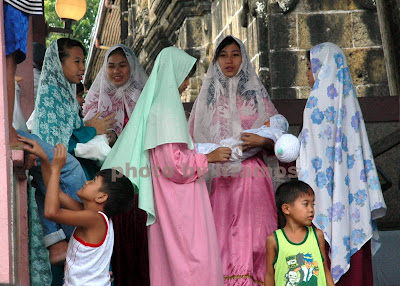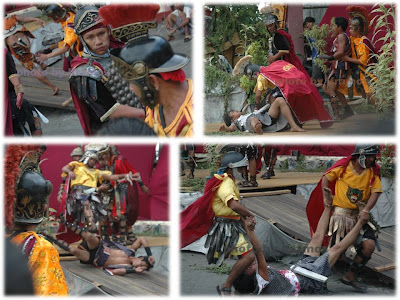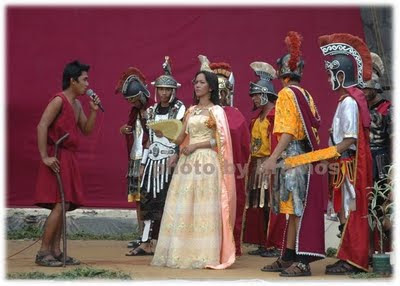 |
| Under the canopy of mahogany, aguho, and other trees in the Hiyas ng Kalikasan Center grow kuribetbet (inset) a.k.a. pandakaki. |
We helped ran two environment-oriented youth events on 25-28 April, 2011 and we came out of it envisioning a botanical inquiry project for high school students all over the province that may lead to a network of town herbariums showcasing the diverse flora--native, indigenous, endemic and introduced--found in Zambales. A pilot project may be initiated by the high school participants from San Narciso and Botolan towns who were taught "collection and preparation [of plant specimens] prior to botanical identification" by an expert, Dr. Edwin Tadiosa of the Botany Division of National Museum.
The twin events were both set at the one-hectare tree farm in San Vicente in San Narciso town, aptly called Hiyas ng Kalikasan Center, owned by Comelec Commissioner Rene Sarmiento and his wife LaRainne.
The first had some 90 elementary schoolchildren from the 17 barangays of San Narciso in a one-day Likhaan para sa Kalikasan (Children’s Nature and Art Workshop) on 25th April. While they did not go through Dr Tadiosa's brief course, they had practical exercises to make them more conscious of and caring for their natural environment. They met with conservation activists who ran the pawikan (sea turtles) hatchery and preservation station in nearby Philippine Merchant Marine Academy (PMMA). They also learned about raising worms to produce organic fertilizers. They gathered leaves, fruits and seeds of the flora growing in the farm, identified them with their local names, and listed the benefits that can be derived from them that they learned from their parents and relatives. We were surprised hearing from them of the medical uses of some plant parts that we've not known before.
The twin events were both set at the one-hectare tree farm in San Vicente in San Narciso town, aptly called Hiyas ng Kalikasan Center, owned by Comelec Commissioner Rene Sarmiento and his wife LaRainne.
The first had some 90 elementary schoolchildren from the 17 barangays of San Narciso in a one-day Likhaan para sa Kalikasan (Children’s Nature and Art Workshop) on 25th April. While they did not go through Dr Tadiosa's brief course, they had practical exercises to make them more conscious of and caring for their natural environment. They met with conservation activists who ran the pawikan (sea turtles) hatchery and preservation station in nearby Philippine Merchant Marine Academy (PMMA). They also learned about raising worms to produce organic fertilizers. They gathered leaves, fruits and seeds of the flora growing in the farm, identified them with their local names, and listed the benefits that can be derived from them that they learned from their parents and relatives. We were surprised hearing from them of the medical uses of some plant parts that we've not known before.
The second event had 30 students from San Narciso and Botolan public and private high schools in a three-day stay-in Growing in Grace and Leading in Wisdom Youth Camp. Although primarily a leadership training for student council members, their course modules were tuned to environmental issues. Their nature tripping included an early morning hike to the pawikan hatchery station, vermiculture for organic gardening, and the collection and preparation of botanical specimens from the farm under the guidance of Dr. Tadiosa.
 |
| Dr Edwin Tadiosa, botanist from the National Museum, demonstrated and guided students in the collection and preparation of plant specimens. |
In his presentation, Dr Tadiosa touched on some flora that are native to Zambales. Their scientific names speak of their provenance: Cycas zambalensis Matulid & Agoo (2005), Ardisia zambalensis Merr. (1915), Bulbophyllum zambalense Ames, Rubus zambalensis Elmer (1908), Astronia zambalensis Elmer, Elaeocarpus zambalensis Elmer (1934), and Evodia zambalensis Elmer (1934).
We looked up these native Zambales flora in The Plant List created by the Royal Botanic Gardens, Kew and Missouri Botanical Garden. All their scientific names except that of the Astronia and the Evodia are listed as "accepted". The two are "unresolved".
The Cycas was the subject of our earlier blog on the Palm Sunday fronds of the people of San Antonio town. Dr Domingo Madulid, who co-discovered it in 2005, says it is a threatened species.
We learned that the Bulbophyllum is an orchid, and there are some 1,955 accepted species names some of which like the zambalense are also Philippine natives-- bataanense, maquilinguense, pampangense, surigaense, zamboangense, among others named after their places of discovery.
We saw pictures of three other Ardisias in Dr Madulid's A Pictorial Cyclopedia of Philippine Ornamental Plants. We presume that the zambalense would have similarities with its cousins confertiflora from Batanes Island ("small, light pink to violet" flowers), crenata ("alternate, dark green and leathery" leaves) and pyramidalis ("round, red turning black" fruits) found in Philippine gardens.
There's just Rubus spp in Dr Madulid's book, which he describes as"small shrubs ... with prickly stems and twigs ... white, pink or red [flowers], usually in clusters ... fruits [that] are usually red or orange berries." There are 23 species in the Philippines, he says, and 15 are endemic to the country.
We hope to find something pictorial on these Zambales species esp. the Astronia, the Elaeocarpus and the Evodia (would this be similar to the imported suaveolens?).
Our encounters with Dr Madulid and Dr Tadiosa made us take a second look at the flora living in our neighborhood.
 | |
| Fruits of the apatot or noni plant in our backyard by the beach. |
There are, for example, several apatot (Ilokano name) trees growing by the fence of our beach house, and they're all bearing fruits. Many don't know it but this is the source of the Noni juice that was the rage of quite recent times. Dr Madulid said they are either the Morinda citrifolia Linn. (usually found in the forest) or Morinda bracteata (found by the beach). We brought a fruit-laden branch to the botanical workshop, and Dr Tadiosa confirmed our plant is a bracteata.
If there's one thing we haven't forgotten since boyhood is this verse we sang out loud when people tended to be selfish with a few coins to spare for our Christmas caroling. It's about gifting them with apatot leaves, and if they get offended, why they should come down so we can pummel them with our bare fists! We dared them with --
Bulong ti apatot / Paskua yo nga naimot / Umulog ti makarurod / Ta narnaran mi ti dandanog! (Leaves of apatot / gifts for selfish ones / Come down if you're angry / And we'll pounced on you!
There are plenty of kuribetbet (Ilokano) in our town, and we remember this to be the most popular shrub during Christmas time. It has plenty of branches, and that makes it best for Christmas trees. This is the pandakaki in other parts of the country, the Tabernaemontana pandacaqui Moir, which is in the list of Philippine folkloric medicinal plants.
We told the high school participants about the science research project of a high school girl from the Ilocos on the use of the pandakaki as a source of organic pesticide against some rice worms. She'd been seeing her grandfather pounding leaves, soaking them in water and spraying the concoction on the rice plants, and she thought of giving the practice a scientific framework. She won a grand award for it at the International Science & Engineering Fair in the US four years ago.
 |
| Banaba trees are a-bloom in our town. |
It's summer and the banaba trees lining the rural roads in our town are blooming profusely. The high school students tarried a bit on their way to the sea turtle hatchery to have their picture taken against a backdrop of violet banaba flowers. Of course, this tree--the Lagerstroemia speciosa Linn.--is widely known for its folkloric medicinal value.
We hope the provincial science coordinator of the Department Education would look at our suggestion of having the high school students start work on an herbariums of Zambales flora. If we heard it right, the leadership training participants included activities along this line in their action plan for next year.
The organizers of the youth training events--Department of Education, Magsaysay Memorial College, Timpuyog Zambales and Education for Life Foundation--will have green projects of teams from five high schools to follow through during the coming school year: pawikan protection, vermi-composting, and herbarium initiatives.








































